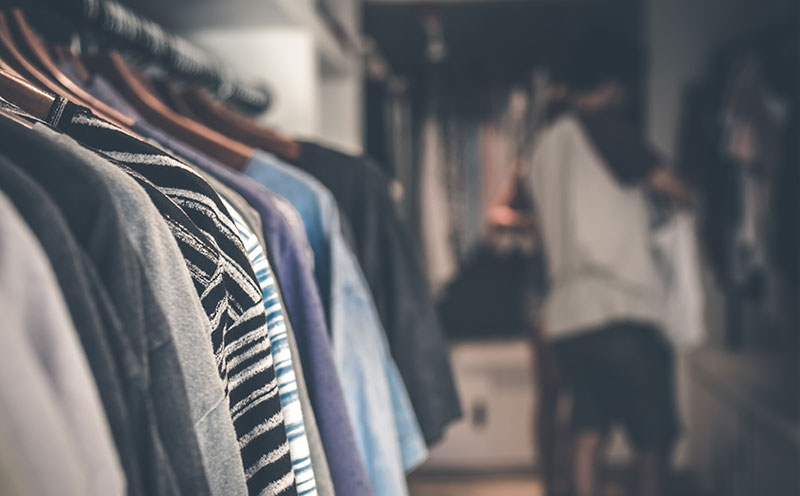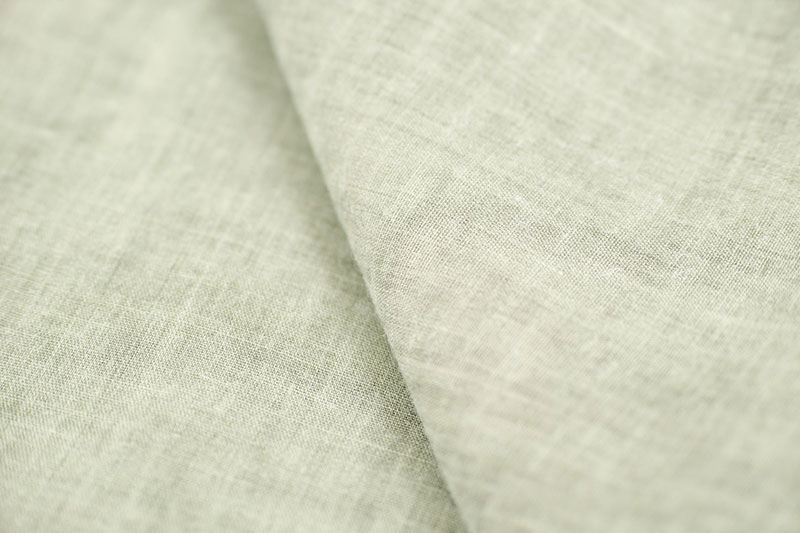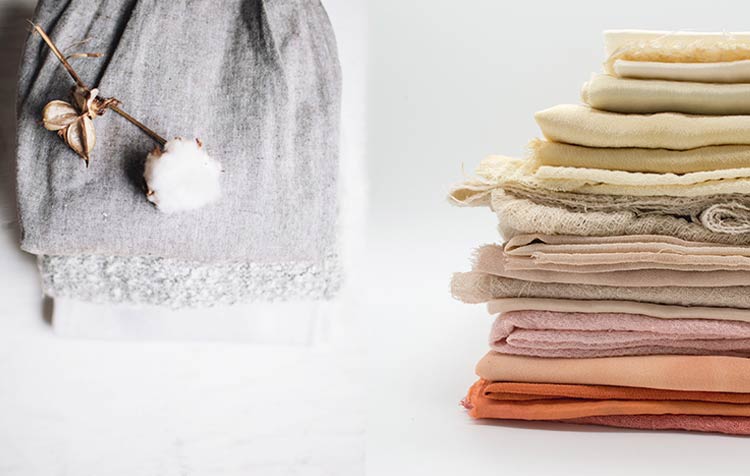You want to know more about sustainable textiles and environmentally friendly fabrics for clothing know? Then you've come to the right place! The Fast Fashion Industry with new trends every week has caused a whole range of ecological, health and social problems. For the American market, 97 percent of all garments are now produced in low-wage countries such as Cambodia or Bangladesh.₁ Countries where people have to slave away in dark factory halls for 2.70 euros a day. In addition, the intensive cultivation of the material often causes problems.
The Slow Fashion is the decelerating counterpart to limit fashion consumption to the bare essentials. But of course we can't do without textiles! In this article, you will find valuable information about the sustainability of certain materials that we use for our textiles.
Ecological advantages and disadvantages of certain textiles

Here I would like to take a look with you now at typical textiles, which are used for garments such as T-shirts, dresses or pants but of course also other everyday items such as napkins or Cloth handkerchiefs be used.
Cotton
In the European Union, cotton is the most popular material for clothing. Around 43 percent of all textile fibers for clothing are made from it.₂ This includes, for example, jeans pants and shirts, for which hard-wearing material such as elastane is also added to the cotton fabric.
Advantages: Baumwolle macht Textilien weich und atmungsaktiv. Zudem sind Baumwoll-Textilien auch für Menschen mit empfindlicher Haut geeignet – und sie lassen sich bequem in der Maschine waschen. Textil- und Bekleidungs-Produkte aus Baumwolle sind außerdem zu einhundert Prozent recycelbar.
Disadvantages: Cotton shrinks during washing and wrinkles easily. From an ecological point of view, the disadvantages are enormous. Conventional cotton tends not to be considered sustainable textiles for the following reasons:
- Water intensive cultivation: for 1 kilogram of cotton about 11,000 liters of water.₃
- Toxic cultivationAbout 25 percent of the world's insecticides are used in cotton cultivation.₄ The poison used, in turn, accelerates the growth of cotton. species extinction enormous.
- Residues: we cannot see the toxin, but it may enter our bodies through our clothing.
Tip: Organic cotton is a sustainable alternative, as the use of pesticides in cultivation is reduced to a minimum. You can recognize them by the eco-labels located on the clothing.
Leather
Conventional leather is made from animal skin and is often - but not always - a "by-product" of the meat industry.
Advantages: Leather is a very tear-resistant, durable and timeless material. The feel and look are very appealing.
Disadvantages: Products made of leather are difficult to repair in case of deeper scratches. From an ethical and ecological point of view, however, conventional leather is extremely critical. On the one hand, because animals are exploited for the material. On the other hand, because the animal skin must be prevented from rotting in environmentally damaging treatment processes. These include, for example, preservatives during transport, chemical tanning, coating, high water consumption, and high wastewater volumes.
Tip: In the article Is leather sustainable? you will learn more about the environmental damage caused by leather production. I'll also show you what natural leather alternatives there are to protect the environment.
Wool
Everyone knows that wool comes from animals - in most cases sheep. We use it, for example, for hats or gloves.
Advantages: Wool hardly wrinkles and is one of the more durable and robust textiles. And instead of washing wool garments, airing them out is sufficient in most cases. Dyeing is relatively simple and therefore environmentally friendly.
Disadvantages: We know that wool can be quite scratchy and needs special care. Since wool is a part of an animal's body, it is usually not a sustainable product. This concerns both ecology and animal ethics. After all, the animal has to be raised and sheared under rough shearing processes just for our need of wool.
Tip: Again, the organic option is of course the much more animal and environmentally friendly alternative. However, it is best to prefer second-hand goods to fulfill your desire for woolen garments without causing unnecessary harm.
Viscose
Viscose refers to chemically treated fibers made from regenerated cellulose that are spun industrially.
Advantages: The natural fibers make our garments very soft. In addition, they do not become electrically charged.
Disadvantages: Viscose is not one of the sustainable textiles, as it contributes to deforestation and the wood has to be processed with the use of chemical poisons. In addition, the material is not particularly robust and therefore not very durable.
Silk
From the protective cocoon of the silk moth caterpillar are made silk clothes.
Advantages: Garments made of silk have a visually appealing, natural luster and do not wrinkle. Silk can protect from both heat and cold. The material is also biodegradable.
Disadvantages: From an ethical-ecological point of view, silk production is extremely questionable. The caterpillars were highly bred and killed in boiling water while still in their pupa phase, as they would otherwise bite the endless silk thread and reduce the textile quality.₅ The material itself is also very difficult to clean and can tear quickly.
Notice: So silk is not in itself a sustainable textile. However, there are types of silk where caterpillars are allowed to hatch from their cocoon beforehand. (e.g. Peace silk or Ahimsa silk).
Tip: More animal-friendly alternatives for the delicate silk include agave fibers, for example, as well as some synthetic fibers (e.g. nylon).
Linen

Among the time-honored sustainable textiles is definitely the fabric obtained from the flax plant.
Advantages: Linen is a very robust and cooling material that feels very comfortable on the skin. From an ecological point of view, it can be grown with relatively low water consumption and minimal use of pesticides.
Disadvantages: Unfortunately, toxins are often used in the bleaching and dyeing process. The material itself is relatively high maintenance.
Tip: Again, to be on the safe side, you should prefer certified organic linen to protect the environment.
Hemp
Hemp is also a natural fiber that is biodegradable and not only for this reason is one of the most sustainable textiles.
Advantages: Hemp can make clothing very breathable, stable and thus also very durable. The cultivation of hemp is very high-yielding and very resource-conserving possible. At the same time, it conserves the nutrient content in the arable soil.
Disadvantages: From an ecological point of view, hemp fibers basically have no disadvantages. The material itself may make garments a little rougher and slightly wrinkled - but that's all.
Tip: Hemp can also be used to produce the valuable Cannabidiol win. I have given you another separate post about the most different Fields of application of CBD written. Look gladly times purely.
Recycled man-made textiles from circular economy
The video already shows impressively that manufacturers or suppliers of textiles should prefer recyclable material as far as possible and also no mixtures of different synthetic fibers. Because as soon as you mix these fibers together, they become hazardous waste that can only be incinerated or landfilled but not recycled.
The following Synthetic fibers are particularly often preferred:
- Elastane: Conventional garments made of elastane can certainly be very durable. However, they have to be manufactured using high levels of chemicals and are therefore harmful to the environment.
- Polyester: The recycling process is relatively energy-intensive. Small fibers of microplastic come off in the washing machine or when swimming with clothes in the sea. Microplastics in the sea is one of the largest but also most underestimated Environmental problems of our time.
- Fleece: For example, a fleece jacket is very durable and resistant. But even if this fabric is recyclable - in terms of secreting microplastics, it is extremely harmful to the environment.
- Nylon: Nylon fibers are very strong and washable, but they also but Microplastics ab. Garments made of nylon are also produced in an extremely energy-intensive and environmentally harmful way.
- Acrylic: This fabric is a vegan alternative for wool. However, it is also a synthetic fiber that secrete microplastics. In addition, it is not recyclable and must be produced costly.
Keiner dieser Stoffe ist biologisch abbaubar. Circular economy sollte daher eigentlich eine normale, gewöhnliche Sache sein, um diese Textilien möglichst nachhaltig nutzen zu können. But if you go after it, it is still considered something rather unusual today. Deshalb hat man heute als Unternehmer große Chancen, gegenüber der Konkurrenz hervorzustechen, indem man die eigenen Produkte, wie zum Beispiel eben Kleidungsstücke, im Sinne der Kreislaufwirtschaft anbietet.
Tip: About sustainable recycling fashion I have also written you a separate contribution. Look gladly times purely.
Sustainable textiles for the protection of the environment
Whether you are a supplier or a buyer of textile goods, always make sure that the goods are Fairtrade and certified organic, if possible. As a retailer, you benefit from the increased awareness of sustainable products. And as a consumer, it's best to prefer second-hand goods. They have shed their dusty image by now, as they can have an enormous impact on the environment and animal welfare, and at the same time still offer a good price. save money through sustainability lets.
Do you have any questions, tips or suggestions about this post on sustainable textiles? Then I look forward to your comment.
Stay sustainable,

PS: In my Fashion Blog from CareElite you can learn much more! For example, check out my post about sustainable fashion on. Have fun!
References:
₁ Fashion United: Trump's economic plans: winners and losers in the fashion industry (as of 04.01.2017), available at https://t1p.de/q4po. [18.08.2020].
₂ European Union (2019): Environmental impact of the textile and clothing industry, available at https://t1p.de/i0vj. [18.08.2020].
₃ Vereinigung Deutscher Gewässerschutz e.V.: Cotton, available at http://virtuelles-wasser.de/baumwolle.html. [18.08.2020].
₄ The VERBRAUCHER INITIATIVE e.V.: The use of pesticides, available at https://t1p.de/qvud. [18.08.2020].
₅ PETA Deutschland e.V.: Silk - Caterpillars are cooked alive in the cocoon (as of May 2018), available at https://www.peta.de/seide. [18.08.2020].






For a birthday we would like to have a custom blanket made. Now the question for us is whether cotton is well suited. Good to know that it can be washed well and at the same time suitable for sensitive skin. That makes the decision easier, thank you!
I was not even aware that hemp is also used for the production of clothing and that it has no disadvantages from an ecological point of view. I'm currently looking a lot into the fabrics used in clothing and how the production affects the environment. Since I'm generally a much bigger fan of second hand fashion, I'm going to check out a good place to buy second hand clothing.
Comments are closed.